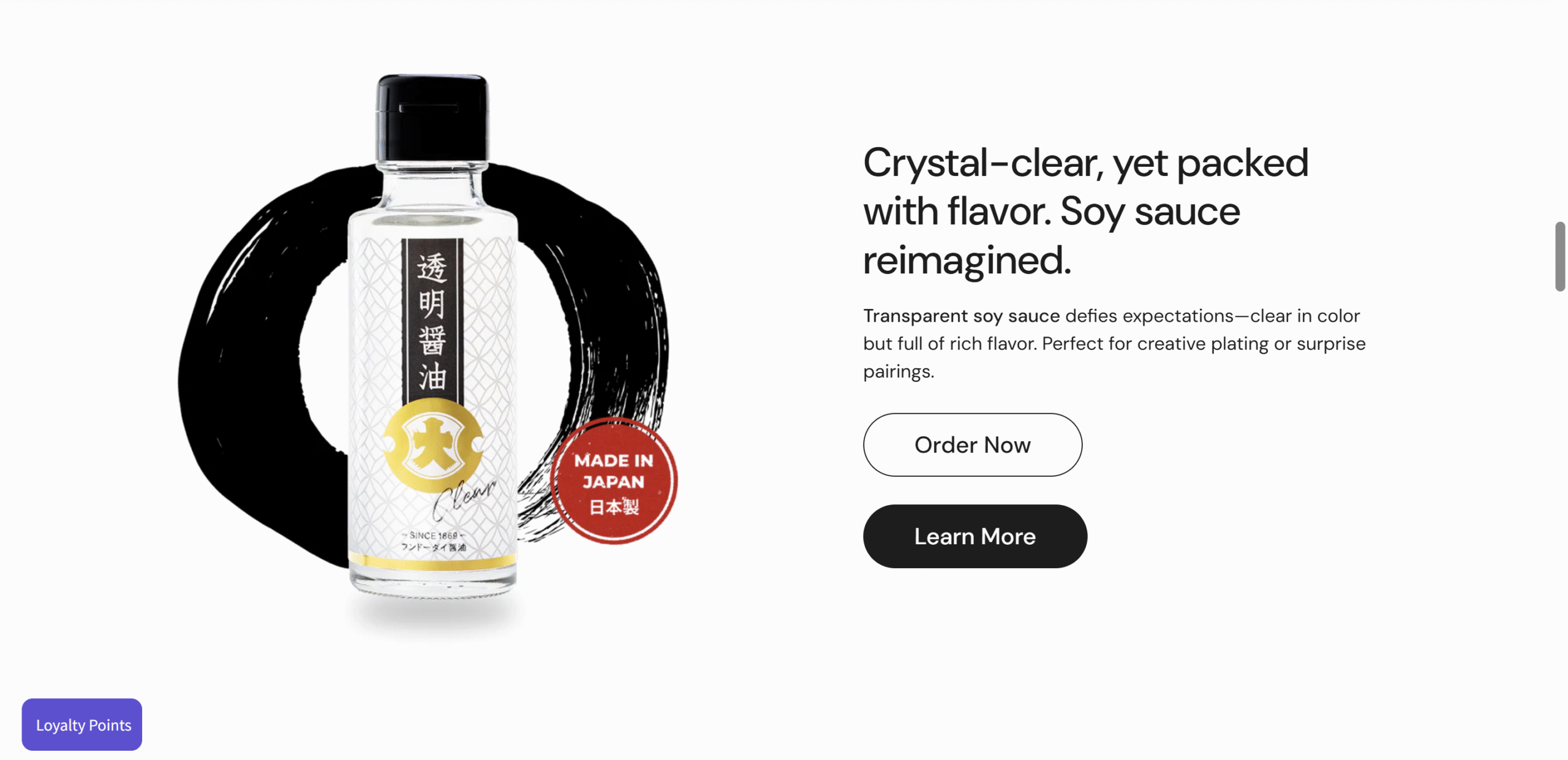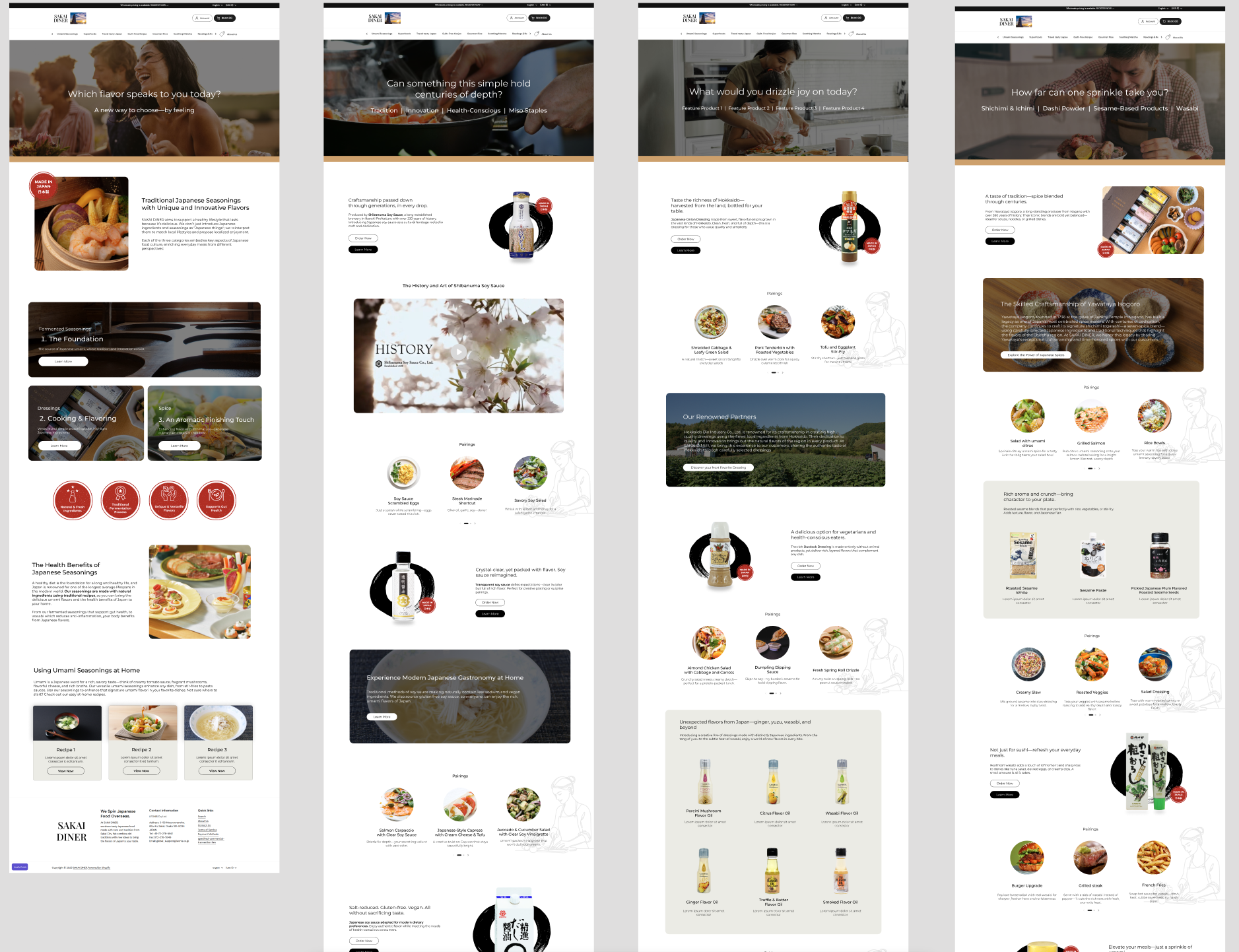Sakai Diner - Project Overview
Challenge
Sakai Diner set out to introduce American high-earners to the depth of Japanese seasonings through its new “Umami Concept” pages. The challenge wasn’t simply translation, it was bridging cultures. How could we preserve authenticity while making Japanese flavors feel approachable and relevant for an audience that admired the cuisine but lacked insider knowledge?
Methods
I began by conducting user interviews and competitor research to understand how American audiences engage with Japanese culinary brands. The findings revealed that Americans respond best to clean, simplified aesthetics that express authenticity and elegance. These insights guided my design process, from early wireframes in Figma to a working prototype built directly in Shopify.
Results
Guided by my findings, I designed a narrative-driven experience that invites exploration. Interactive hover states and carousels maintain engagement without overwhelming users. Each section builds trust and curiosity by centering the product, grounding it in cultural context, and ending with quick-view recipes that encourage real-world application. The result is an experience that educates, converts, and celebrates authentic Japanese flavor.
Breakdown
Site Objectives and Identity
At the start of this project, I collaborated with the Sakai Diner team in Japan to define their site objectives, target audience, and existing brand guidelines.
Target Demographic
Americans aged 20-40, high-earners interested in Japanese food and exploratory cooking
Site Goals
Educate visitors on Japanese flavors, build trust, and convert visitors into customers
Brand Guidelines
Sakai Diner uses a specific Shopify theme with established brand guidelines.
User Needs & Competitor Research
Through interviews, I found that Americans admired Japanese cuisine but felt overwhelmed by websites that assumed insider knowledge. They sought approachable, visually rich education that felt both genuine and easy to digest. I created a persona based on the results of the interviews to easily share and reference my findings.
Competitor research confirmed this need: American-facing Japanese brands that performed best didn’t dilute authenticity — they framed it within clean, modern layouts, generous whitespace, and concise storytelling. Japanese-market sites, by contrast, favored dense, text-heavy designs.
These insights guided my approach: honor the cultural authenticity of Japanese cuisine while reimagining its presentation for clarity, accessibility, and visual appeal.

Amelia Smith - Nurse, Mom
I'm interested in making Japanese food, but I'm not sure where to start
Goals
– Cook food quickly and easily at home
– Explore new flavors and make delicious meals
Challenges
– Cook food quickly and easily at home
– Explore new flavors and make delicious meals
Demographics
– Gender: woman
– Location: Los Angeles, CA
Interaction & Interface Design
I designed an intuitive navigation structure that guides users through an educational journey about umami and Japanese seasonings. The design process involved several iterations to balance Sakai Diner’s content requirements with user needs, ensuring we included all the information they wanted to convey without overwhelming visitors. The final design included sections that follow a hierarchical structure that builds trust and drives product engagement: each section features the product prominently in the center, optionally includes any meaningful tradition and background information, and concludes with smaller quick-view recipe suggestions. This layout strategy increases user interest while reducing friction in the path to purchase. I designed button hover states and carousels for a clean view of recipes/pairings without overwhelming the viewer with information.
Design
Visual Design
Initial designs focused heavily on product photography, but lacked the emotional connection needed to inspire home cooks. Through three iterations, I shifted toward people-focused imagery that showcases cooking experiences and cultural moments, evoking warmth and happiness rather than clinical product presentation. To address the challenge of conveying authenticity, I researched traditional Japanese art and created custom graphics including a red “Made in Japan” stamp mimicking traditional hanko seals and black ink swooshes inspired by Japanese ink painting. Both elements draw the eye to featured products while reinforcing cultural legitimacy. The final design employs generous whitespace and a muted color palette with red accents, solving the tension between minimalist American preferences and rich Japanese tradition.
Technical Implementation
Working within the constraints of Sakai Diner’s Shopify theme, I developed any custom sections using HTML, Liquid, and CSS. I optimized the site for performance and mobile responsiveness, ensuring fast load times crucial for e-commerce conversion. The implementation included custom product filtering logic, dynamic content modules, and integration with Shopify’s inventory system. I also established a modular design system that allows the Sakai Diner team to easily create new pages and update content without requiring developer support.

